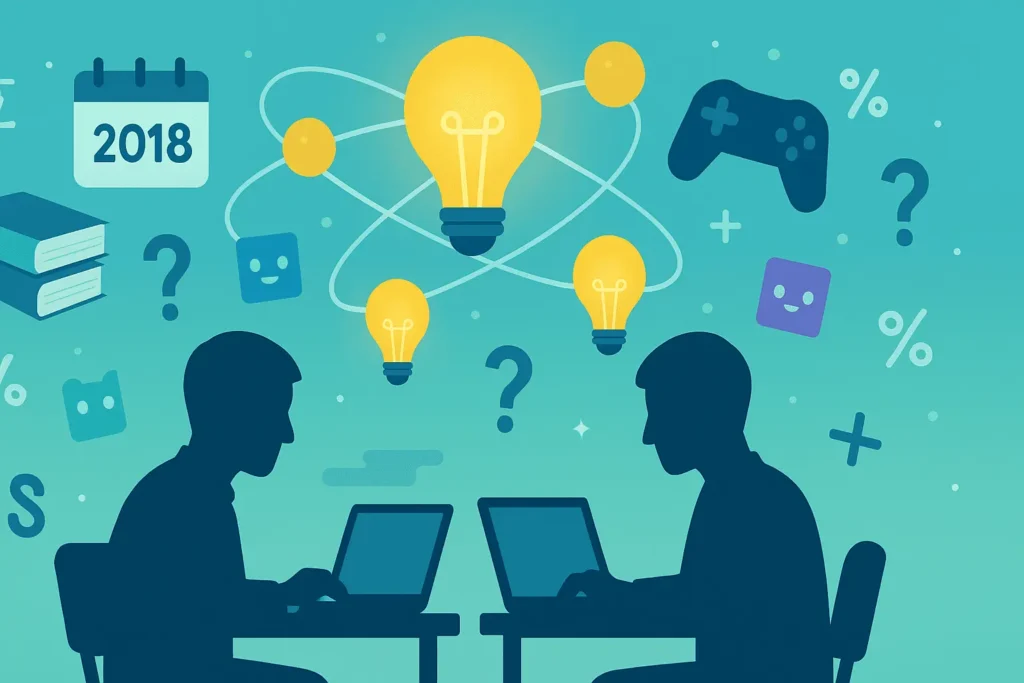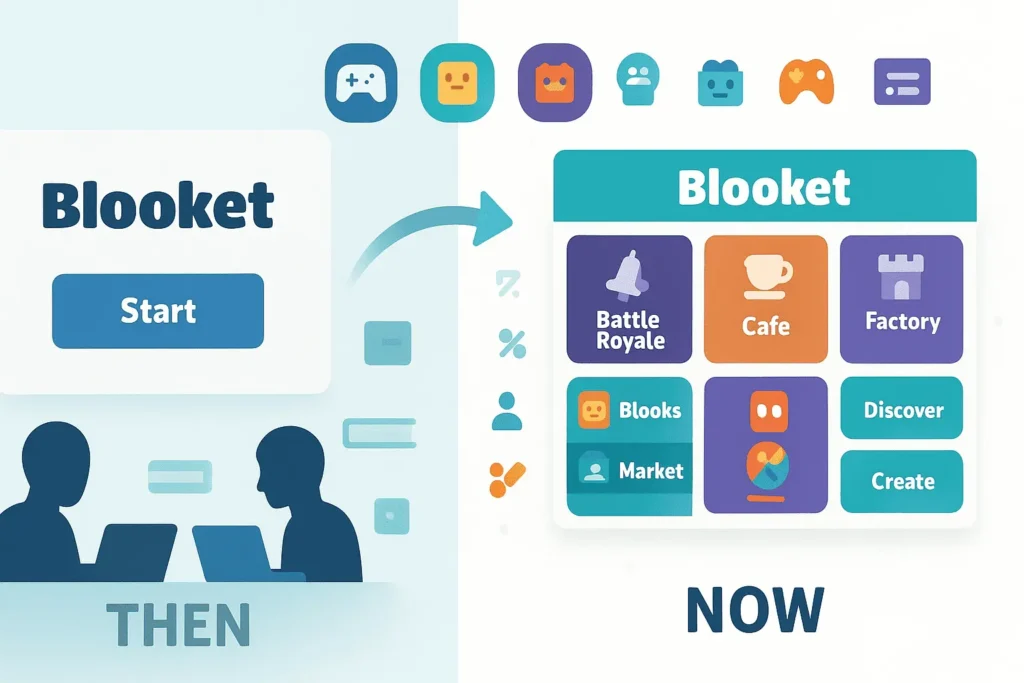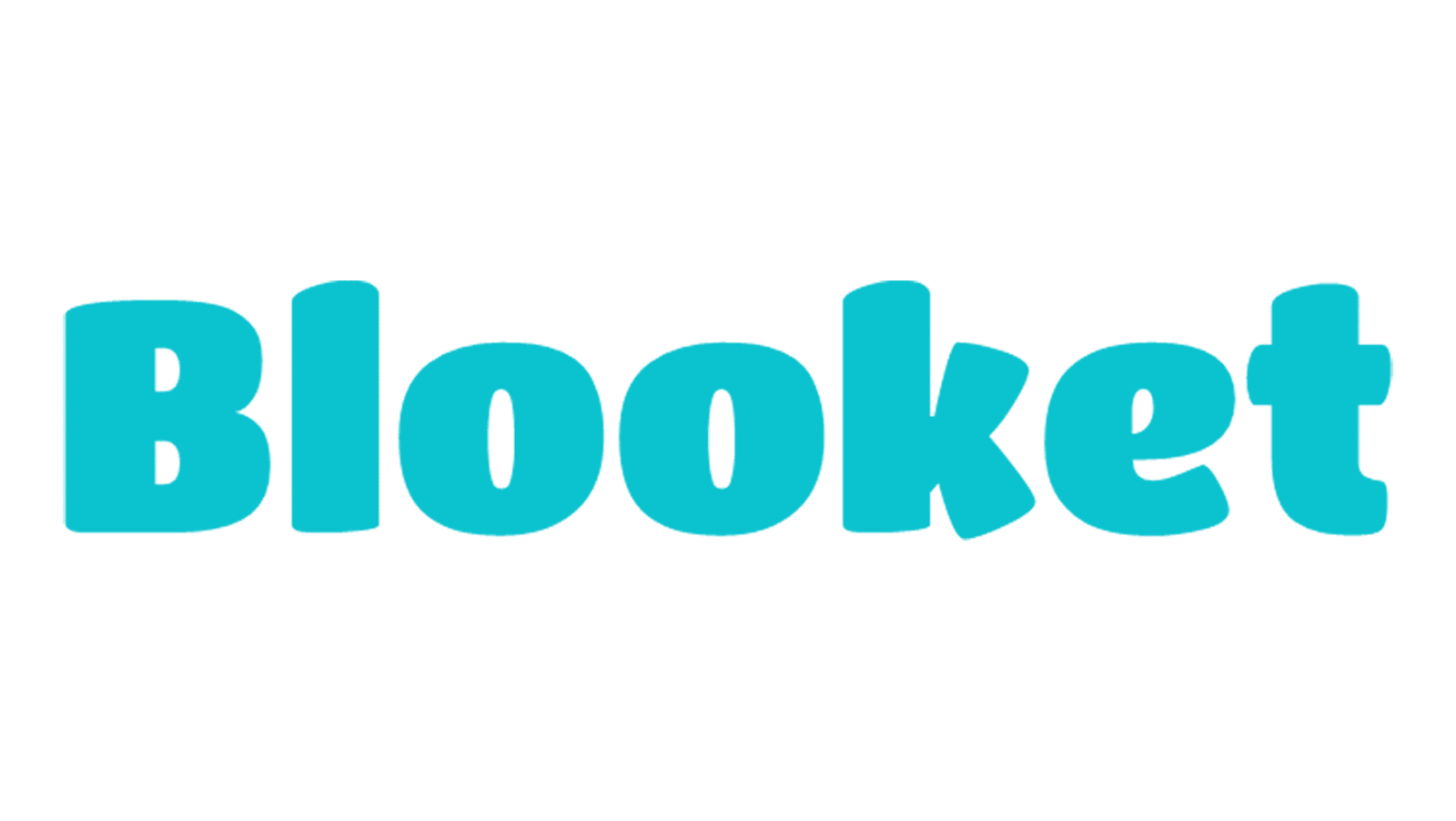If you’ve spent any time in a modern classroom—or have kids in school—chances are you’ve heard excited chatter about Blooket. Students love it. Teachers swear by it. And if you’re wondering when did Blooket release and how it became such a phenomenon so quickly, you’re definitely not alone.
I remember the first time I heard about Blooket from my nephew’s teacher. She was raving about this “game-changing” platform that made her students actually excited about pop quizzes. Coming from someone who’d tried every educational tool under the sun, that was high praise. So I dove deep into Blooket’s history, and what I discovered is a fascinating story of innovation, perfect timing, and two brothers who simply wanted to make learning more fun.
Whether you’re a teacher evaluating Blooket for your classroom, a parent curious about what your kids are playing, or just someone interested in educational technology, this complete guide will walk you through everything: the official release date, the founders’ story, how the platform evolved, and what makes it so popular today.
Let’s explore the journey of how Blooket went from a simple idea to one of the most beloved educational platforms in schools worldwide.
The Official Answer: When Did Blooket Release?
Let’s start with the facts you came here for.
Blooket officially launched in 2020, though its story begins earlier than that.
The platform was founded by brothers Tom and Ben Stewart in 2018, but the public release that most people remember—when Blooket became widely available to teachers and students—happened in 2020. This timing, somewhat serendipitously, coincided with a massive shift to online and hybrid learning due to the COVID-19 pandemic.
The Timeline at a Glance
2018 – Tom and Ben Stewart begin developing Blooket, recognizing the need for more engaging educational games
2019 – Beta testing phase with select schools and early adopter teachers
2020 – Official public release; Blooket becomes available to all teachers and students
2021 – Explosive growth as schools worldwide embrace the platform; major feature expansions
2022 – Introduction of Blooket Plus subscription and advanced features
2023 – Platform reaches millions of active users; continuous game mode additions
2024-2025 – Ongoing innovation with community events, seasonal content, and enhanced analytics
Understanding when Blooket released matters because it puts the platform’s rapid growth in context. In just five years, Blooket went from a startup idea to a staple in classrooms across multiple countries—an impressive feat in the competitive educational technology space.

Who Made Blooket? Meet the Creators
Behind every great platform is a great story, and Blooket’s begins with two brothers who saw an opportunity to revolutionize classroom engagement.
The Stewart Brothers: Tom and Ben
Tom and Ben Stewart are the founders and creators of Blooket. Both had backgrounds in education and technology, which proved to be the perfect combination for building an educational gaming platform.
What Inspired Them:
The brothers noticed a consistent problem in classrooms: students disengaged during review sessions and quizzes. Traditional flashcards were boring. Worksheets felt like punishment. Even early educational games often felt more “educational” than “game.”
Tom and Ben asked themselves a simple question: “What if we made review games that students actually wanted to play?”
That question led to Blooket.
The Philosophy Behind Blooket
The founders built Blooket on several core principles:
1. Learning Through Play They believed that education didn’t have to feel like work. By incorporating genuine game mechanics—strategy, competition, resource management—learning becomes a natural byproduct of having fun.
2. Teacher Control Unlike some educational platforms that dictate how teachers must use them, Blooket was designed to be flexible. Teachers can create custom content, choose game modes that fit their teaching style, and adapt the platform to their specific needs.
3. Continuous Innovation From the beginning, the Stewart brothers committed to regular updates, new game modes, and listening to community feedback. This responsiveness has been key to Blooket’s sustained growth.
Why “Blooket”?
The name “Blooket” combines “block” and “set”—representing the blocky Blook characters and the question sets that power the games. It’s simple, memorable, and perfectly captures the platform’s playful nature.

How Blooket Evolved: From Launch to Today
Since Blooket released in 2020, the platform has undergone remarkable evolution. Let’s look at how it grew from a simple quiz platform into the comprehensive educational tool it is today.
The 2020 Launch: Simple but Effective
When Blooket first became publicly available, it offered:
- Basic game modes (primarily Gold Quest and Tower Defense)
- Simple question set creation tools
- Limited Blook characters to unlock
- Free access for all teachers and students
- Basic game hosting capabilities
Even in this simpler form, Blooket immediately stood out. Teachers appreciated the easy setup, and students loved the game mechanics.
2021: The Breakthrough Year
This was when Blooket truly exploded in popularity.
New Features Added:
- Multiple new game modes (Cafe, Racing, Factory)
- Expanded Blook collections with rarity tiers
- Homework assignment capabilities
- Basic analytics for teachers
- Community question set sharing
Why It Took Off: Schools were still navigating hybrid and remote learning. Blooket’s browser-based accessibility meant students could play from any device—Chromebooks, tablets, phones—making it perfect for diverse learning environments.
2022: Monetization and Enhancement
Blooket Plus launched, offering premium features:
- Enhanced analytics and reporting
- Larger class sizes (beyond 60 students)
- Priority support
- Advanced customization options
The free version remained robust, ensuring accessibility while giving dedicated teachers tools to go deeper.
2023-2024: Community and Competition
Recent years have seen Blooket focus on:
- Seasonal events and limited-time game modes
- Community challenges and tournaments
- Social features for connecting classrooms
- Continuous new Blook releases
- Integration capabilities with learning management systems
2025 and Beyond: What’s Next?
The platform continues evolving with:
- AI-powered question generation tools (in development)
- Enhanced mobile apps
- More sophisticated analytics for data-driven instruction
- Expanded international language support
- New game modes based on user feedback
Understanding All Blooks in Blooket
One of Blooket’s most beloved features—and a major driver of student engagement—is the Blook system. These adorable block characters are what make Blooket uniquely appealing.
What Are Blooks?
Blooks (a portmanteau of “block” and “look”) are collectible avatar characters that represent players during games. They come in various designs, themes, and rarity levels.
Blook Rarity Tiers
When you explore all Blooks in Blooket, you’ll find they’re organized by rarity:
Common Blooks (Most Abundant)
- Easy to unlock through regular gameplay
- Basic designs but still charming
- Examples: Chick, Cow, Pig, Duck
- High drop rates from standard boxes
Uncommon Blooks
- Slightly more interesting designs
- Moderate unlock difficulty
- Examples: Frog, Owl, Tiger
- Appear less frequently than commons
Rare Blooks
- Distinctive designs that stand out
- Require more gameplay to unlock
- Examples: Dragon, Astronaut, Unicorn
- Drop rates around 5-10%
Epic Blooks
- Impressive, highly detailed designs
- Significant time investment to obtain
- Examples: Rainbow Panda, King, Wizard
- Drop rates around 1-3%
Legendary Blooks (Rarest)
- The crown jewels of Blook collections
- Extremely low drop rates (often under 1%)
- Examples: Megalodon, Tim the Alien, Rainbow Astronaut
- Major status symbols among students
Special Event Blooks
Beyond standard rarity tiers, Blooket regularly releases:
- Seasonal Blooks (Halloween, Christmas, Spring)
- Limited-Time Event Blooks
- Achievement Blooks (earned through specific accomplishments)
- Challenge Blooks (from community events)
Why Blooks Matter
This might seem like a small feature, but Blooket blooks are actually genius game design:
For Students:
- Provides intrinsic motivation beyond grades
- Creates a sense of progression and achievement
- Gives students conversation topics and bragging rights
- Makes them want to play more games
For Teachers:
- Increases voluntary participation
- Provides informal rewards without extra work
- Creates excitement around educational activities
- Helps maintain long-term engagement
I’ve talked to teachers who’ve seen students voluntarily play Blooket at home just to unlock new Blooks—meaning they’re essentially choosing to do extra homework. That’s the power of good gamification.
How to Find Blooket Codes Live and Active Games
One common search related to Blooket is finding Blooket codes live or Blooket game pins that always work. Let’s clarify what this means and how it works.
Understanding Blooket Game Codes
When teachers host Blooket games, they generate unique game codes (typically 6-7 characters). Students use these codes to join specific game sessions.
Important Clarification: These codes are temporary and session-specific. There’s no such thing as Blooket game pins that always work because codes expire once games end.
Where to Find Active Games
If you’re looking to join random Blooket games:
Social Media Platforms:
- Twitter: Search #Blooket or #BlooketLive
- Discord: Join Blooket community servers
- Reddit: r/Blooket often has active code sharing
- Facebook: Blooket teacher groups occasionally share public games
Best Times to Find Active Codes:
- Weekday afternoons (2-5 PM local time) when schools are active
- Lunchtime periods (11 AM-1 PM)
- Evening homework hours (6-8 PM)
- During school exam periods for review games
For Teachers: Hosting Public Games
If you’re a teacher considering sharing codes publicly:
Benefits:
- Connects your students with broader learning community
- Provides practice opportunities outside class time
- Builds excitement around your subject matter
Considerations:
- Unknown players can join public games
- Manage usernames appropriately
- Monitor chat features if enabled
- Consider using public games for review, not assessment
Blooket vs. Other Educational Gaming Platforms
Since when Blooket released, it’s often compared to other educational gaming platforms. Understanding these comparisons helps explain Blooket’s unique appeal.
Blooket vs. Kahoot
Kahoot (launched 2013) was the original educational gaming pioneer.
Similarities:
- Quiz-based gameplay
- Teacher hosts, students join with codes
- Focus on engagement and competition
How Blooket Differs:
- More game modes (15+ vs. Kahoot’s primarily quiz format)
- Collectible Blooks (adds progression system Kahoot lacks)
- Solo play options (Kahoot requires host)
- Different pacing (Blooket allows self-paced in many modes)
- Resource management (some Blooket modes include strategy)
When to Choose Each:
- Kahoot: Quick, straightforward quizzes; whole-class review
- Blooket: Extended gameplay; diverse learning styles; independent practice
Blooket vs. Quizizz
Quizizz (launched 2015) offers self-paced quizzes with memes and humor.
Similarities:
- Self-paced question answering
- Homework assignment capabilities
- Free core features
How Blooket Differs:
- Game mechanics (Quizizz is quiz-focused; Blooket adds gaming layers)
- Visual style (Blooket’s Blooks vs. Quizizz’s meme approach)
- Teacher control (Blooket offers more game mode variety)
Blooket vs. Gimkit
Gimkit (launched 2017) was created by a high school student and focuses on earning in-game currency.
Similarities:
- Gamification of learning
- Student-friendly interfaces
- Strategic elements beyond just answering questions
How Blooket Differs:
- More game variety (Gimkit has fewer distinct modes)
- Blook collection system (unique to Blooket)
- Community size (Blooket has larger user base since 2020)
- Free features (Blooket’s free tier is more robust)
What Makes Blooket Special
After evaluating all these platforms, here’s why Blooket stands out:
- Variety Without Complexity – Multiple game modes but all are intuitive
- Collectibles Drive Engagement – Blooks create lasting motivation
- Teacher Flexibility – Adapts to many teaching styles
- Modern Launch – Built with current tech and recent pedagogy in mind
- Active Development – Regular updates and community responsiveness
The Secret to Blooket’s Success
Understanding when did Blooket release is just the beginning. The more interesting question is: why did it succeed so dramatically?
Perfect Timing
Launching in 2020 meant Blooket hit the market exactly when schools needed it most:
- Remote learning required engaging online tools
- Teachers were exploring new platforms
- Students needed motivation in virtual classrooms
- Schools had budget for educational technology
Student-First Design
Many educational platforms are designed for teachers first, students second. Blooket flipped this:
- Games are genuinely fun, not just “educational”
- Blooks provide intrinsic motivation
- Gameplay feels like actual gaming
- No “talking down” to students
Teacher Empowerment
While student-focused, Blooket doesn’t forget teachers:
- Simple setup (games launch in under 2 minutes)
- Flexible content creation
- Useful analytics without overwhelming data
- Community-shared resources
- Responsive support
Community Building
The platform fostered a community where:
- Teachers share question sets
- Students discuss strategies and Blooks
- Feedback directly influences development
- Regular events keep things fresh
Freemium Done Right
Blooket’s monetization doesn’t feel predatory:
- Core features remain free
- Premium feels like enhancement, not necessity
- No ads in student experiences
- Transparent pricing
How Blooket Changed Education
Since Blooket released, it’s had measurable impacts on education:
Increased Voluntary Participation
Teachers report:
- 85%+ participation rates in Blooket activities
- Students playing voluntarily outside class
- Reduced resistance to review sessions
- More excited engagement with content
Leveled Playing Field
Blooket democratizes engagement:
- Quiet students participate equally
- Different learning styles all find connection points
- Competition feels friendly rather than intimidating
- Success isn’t just about being fastest
Data-Driven Instruction
The platform helps teachers:
- Identify struggling concepts immediately
- Differentiate instruction based on results
- Track progress over time
- Make informed teaching decisions
Home-School Connection
Parents appreciate:
- Knowing what their kids are learning
- Seeing genuine excitement about school
- Ability to play together as family activity
- Safe, age-appropriate gaming content
Frequently Asked Questions
When did Blooket release officially?
Blooket officially released to the public in 2020, though founders Tom and Ben Stewart began development in 2018. The public launch coincided with increased demand for online educational tools during the pandemic.
Who made Blooket and why?
Brothers Tom and Ben Stewart created Blooket because they saw students disengaged during traditional review activities. They wanted to build educational games that students actually chose to play, making learning fun rather than feeling like work.
Are there Blooket game pins that always work?
No. Blooket game codes (pins) are temporary and expire once games end. Teachers generate new codes for each game session. To find active games, search social media platforms for recently shared codes from live sessions.
How many Blooks are there in Blooket?
Blooket regularly adds new Blooks, so the total changes frequently. As of 2025, there are over 100 unique Blooks across all rarity levels, including commons, uncommons, rares, epics, legendaries, and special event Blooks.
Is Blooket free for teachers and students?
Yes! Blooket’s core features are completely free for both teachers and students. A premium subscription called Blooket Plus ($2.99/month or $29.99/year) offers additional features, but the free version provides everything needed for engaging gameplay.
Can I play Blooket without joining a teacher’s game?
Yes! Students can use Blooket’s “Discover” feature to find public question sets and play in solo mode without needing a teacher-hosted game. This makes Blooket useful for independent study and practice.
The Future of Blooket
Looking ahead from 2025, Blooket shows no signs of slowing down.
Upcoming Developments
Based on community forums and hints from the development team:
AI Integration
- Automated question generation from textbooks
- Personalized difficulty adjustment
- Smart study recommendations
Enhanced Mobile Experience
- Dedicated native apps for iOS and Android
- Offline gameplay capabilities
- Better mobile-specific features
Expanded Content Libraries
- More pre-made question sets
- Official curriculum alignment
- Subject-specific Blook collections
Advanced Analytics
- Predictive performance insights
- Long-term progress tracking
- Class comparison tools
International Growth
- More language options
- Region-specific content
- Global tournaments and events
Challenges Ahead
Every platform faces obstacles:
- Maintaining freshness as competition increases
- Balancing monetization with accessibility
- Scaling infrastructure for growing user base
- Keeping pace with educational standards changes
However, given Blooket’s track record since its 2020 release, the team seems well-positioned to navigate these challenges.
Conclusion: More Than Just a Release Date
So when did Blooket release? Officially in 2020. But that’s just a date on a timeline.
The real story of Blooket is about two brothers who recognized that learning didn’t have to be boring. It’s about teachers who embraced new tools to reach their students. It’s about kids who discovered that educational games could actually be fun. And it’s about a community that formed around shared excitement for making education better.
From its humble beginnings in 2018 to today’s platform serving millions of users worldwide, Blooket represents something bigger than just another educational tool—it’s proof that when you truly understand your users and build something with genuine care, success follows naturally.
Ready to Experience Blooket for Yourself?
Whether you’re a teacher looking to revolutionize your classroom engagement or a parent wanting to understand what has your kids so excited, there’s never been a better time to explore Blooket.
Next Steps:
- Teachers: Create your free account and host your first game this week
- Students: Ask your teacher about using Blooket for review sessions
- Parents: Suggest Blooket to your child’s teacher or play together at home
- Everyone: Visit Blooket.com to see what makes it special
The platform that launched in 2020 is still growing, still innovating, and still making learning more engaging one game at a time. Why not see for yourself what millions of educators and students have already discovered?
Join the Blooket community today and discover why timing, innovation, and genuine care for education created something truly special.

